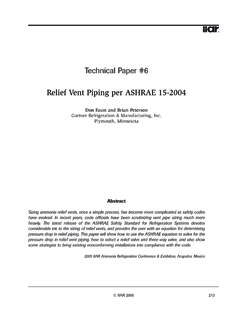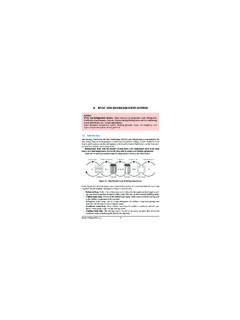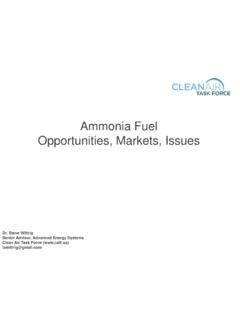Transcription of IIAR Minimum Safety Criteria for a Safe Ammonia ...
1 International Institute ofAmmonia RefrigerationBulletin No. 109 10/97 Guidelines for: iiar MinimumSafety Criteria fora safe iiar 3/14/00 8:26 AM Page 1 NOTICEThe information contained in these guidelines has beenobtained from sources believed to be reliable. However,it should not be assumed that all acceptable methods orprocedures are contained in this document, or thatadditional measures may not be required under certaincircumstances or conditions. The International Institute of Ammonia Refrigerationmakes no warranty or representation, and assumes no liability or responsibility, in connection with anyinformation contained in this document. While the Institute recommends use of and reference to this document by private industry, governmentagencies and others, this publication is intended to be voluntary and not binding. The Institute does not approve or endorse anyproducts, services or methods.
2 This document shouldnot be used or referenced in any way which would implysuch approval or iiar 3/14/00 8:26 AM Page 2 Table of Contents1. Safety .. and Tube Heat Exchangers and Pressure Vessels .. Air Evaporators .. Pumps .. Liquid Level Indicators .. system .. Machinery Room Ventilation system .. Devices .. General Ammonia refrigeration system Safety Requirements ..75. FREQUENCY OF Safety TITLES AND SOURCES OF INSPECTION No. 109 10/97 International Institute ofAmmonia iiar 3/14/00 8:26 AM Page iiar 3/14/00 8:26 AM Page 4 MINIMUMSAFETYCRITERIA FOR ASAFEAMMONIAREFRIGERATIONSYSTEM11. PURPOSEThe purpose of this bulletin is to present the Minimum Safety Criteria and associated data sheetsrecommended for a safe Ammonia refrigeration system for use by qualified individuals makingsafety bulletin identifies mandatory Safety requirements from the Safety codes andstandards listed in Section 6 and Safety recommendations.
3 It includes inspection datasheets and serves as a convenient check list of Criteria governing a safe ammoniarefrigeration bulletin is not intended to replace or provide substitute for the Safety codes and standards listed in Section inspections shall take into account all relevant local laws, regulations, codesand standards not identified in this 6 lists the titles and sources of the codes and standards referenced in DEFINITIONS qualified individualAn individual qualified through adequate training and experience to service, maintainand operate a refrigerating system with which that individual has become (shall not)Used where the provision is mandatory and typically extracted from and referenced toa code or standard listed in Section (should not)Used where the provision is not mandatory, but is recommended good Safety Ammonia refrigeration compressors shall have a legible manufacturer s name plateto include the following Minimum data:a) Manufacturer s nameb) Serial numberc) Model numberd) Year of manufacturee) Maximum design working pressuref) Refrigerant Ammonia g) Rotation speed - rpm, iiar 3/14/00 8:26 AM Page 1h) Direction of rotationi) Flow direction[Section of ANSI/ iiar 2-1992] compressor without a nameplate (see Section ) should not be operated unless the applicable compressor operating limitations have been verified through the identification of the manufacturer and model number of the compressor fromcasting refrigeration compressors should be operated within the limitations specified by the compressor manufacturer.
4 As a Minimum , the following limitations should be checked:a) Compressor speedb) Compressor ratioc) Compressor design discharge pressured) Compressor design maximum crankcase/housing pressuree) Compressor designed for use with Ammonia compressor drive motor should comply with all local, state and national codes andshould appear to be in good positive displacement Ammonia compressor shall be equipped with an internal or external compressor pressure-relief device of adequate size and pressure setting to prevent rupture of the compressor.[Section (c) of ANSI/ iiar 2-1992 and Section of ANSI/ASHRAE 15-1994]If the discharge of the pressure relief device is vented to atmosphere, it shall be pipedin accordance with Sections and of ANSI/ iiar compressor should be fitted with suction stop valve(s), discharge stop valve(s)and a discharge check compressor shall be equipped with the following operable Safety controls as a Minimum .
5 A) Low pressure cutout switchb) High pressure cutout switchc) Low oil pressure cutout switch (if the compressor uses forced feed lubrication)[Section of ANSI/ iiar 2-1992] compressor should be inspected for any signs of alteration, modification, or physical repair that might affect the integrity of the compressor the compressor casing has been altered, modified or repaired, the casing shouldhave been pressure recertified by the manufacturer or the insurance underwriter andrecertification papers maintained on compressor should be fitted with indicating device(s) such that an observer candetermine the compressor s suction and discharge pressures, oil pressure (if thecompressor uses forced feed lubrication) and discharge iiar 3/14/00 8:26 AM Page compressor should be observed while in operation and checked for excessive vibrations, tight anchor bolts, general cleanliness, and other conditions that affect evaporative condensers should be adequately anchored and to evaporative condensers for normal service requirements should not pose a hazard to service and maintenance excessive fan and/or drive vibrations should be entirety of each condenser should be inspected for coil, mist eliminators and the water sump on each condenser should be checkedfor dirt/scale build efficacy of the water distribution system and mist eliminators on each condensershould be and Tube Heat Exchangers and Pressure Shell and Tube Heat ExchangersAll shell and tube heat exchangers shall have a name plate with the following minimumdata.
6 A) Manufacturer s name (preceded by the words certified by , if the vessel is ASME stamped)b) Serial numberc) Model numberd) Year of manufacturee) Design pressureShell side pressure ____ at ____ temperatureTube side pressure ____ at ____ temperaturef) Test pressure appliedg) National Board Number (where applicable)h) Manufacturer s ASME stamp (where applicable)In addition, shell and tube evaporators shall include the following data in accordancewith the relevant UG sections of the latest edition of Section VIII, Division I, ASMEB oiler and Pressure Vessel Code:i) Type of construction in accordance with the above referenced ASME Code (whereapplicable)j) An additional pressure and temperature stamping may be required with referenceto exchangers used below -20 F ( C)[Sections ; ; and of ANSI/ iiar 2-1992]MINIMUMSAFETYCRITERIA FOR iiar 3/14/00 8:26 AM Page Pressure VesselsAll pressure vessels shall have a name plate with the following Minimum data:a) Manufacturer s name (preceded by the words certified by , if the vessel is ASME stamped)b) Serial numberc) Model numberd) Year of manufacturee) Maximum allowable pressure ____ at ____ temperaturef) Test pressure appliedg) National Board Number (where applicable)h) Manufacturer s ASME stamp (where applicable)In addition, pressure vessels shall include the following data in accordance with the relevant UG sections of the latest edition of Section VIII, Division I, ASME Boiler andPressure Vessel Code, including.
7 I) Type of construction in accordance with the above referenced ASME Code (whereapplicable)j) An additional pressure and temperature stamping may be required with referenceto exchangers used below -20 F ( C)[Sections ; and of ANSI/ iiar 2-1992] should be determined that the heat exchanger or pressure vessel is piped and operated within the pressure and temperature limitations as specified on the nameplate shell side of shell and tube heat exchangers and all pressure vessels shall be provided with adequate opening(s) for the attachment of pressure relief device(s) asrequired in Section of ANSI/ iiar 2-1992.[Sections ); ); ); and ) of ANSI/ iiar 2-1992]When the tube side of a shell and tube heat exchanger contains refrigerant and can be isolated by valves on the inlet and outlet lines a pressure relief device(s) shall beprovided to protect the unit from excess hydrostatic pressure, in accordance withSection of ANSI/ iiar 2-1992.
8 [Section ) of ANSI/ iiar 2-1992] any heat exchanger or pressure vessel name plate is covered with insulation, theinsulation should be removed to allow name plate inspection. The insulation shouldthen be repaired and an insulation plug provided to cover the name plate area and to provide future the heat exchanger or pressure vessel shows signs of corrosion beyond mild surface corrosion, the heat exchanger or pressure vessel should be further inspected forsoundness by a professional engineer with expertise in the field, or an ASME to heat exchangers and pressure vessels shall be allowed only as directedby the governing body, for example: ASME; National Board; and shall only be per-formed in accordance with the requirements of the governing body. A retesting stampshall be applied by the governing body when the modification is completed, if iiar 3/14/00 8:26 AM Page heat exchangers and pressure vessels should be identified with a componentmarker that identifies the particular component.
9 The marker should also provideinformation regarding the operating temperature or pressure of the component asdescribed in iiar Bulletin 114, Guidelines for: Identification of Ammonia RefrigerationPiping and system Components . to Section , below, for visual liquid level indicator Safety Air evaporators should be properly anchored and should be installed in locations where they are not exposed to possible physical damage through traffic hazards, for example: evaporators and associated piping should be kept free from excessive buildup of excessive fan and/or drive vibrations should be entirety of each evaporator should be inspected for refrigerant pumps shall be suitable for the service in which they are pumps shall be installed with isolation hydrostatic or differential pressure-relief device (or non-closeable vent pipe) shall be used for pressure protection of a liquid pump and its associated piping.
10 [Section of ANSI/ iiar 2-1992] Liquid Level Indicators (Bulls Eyes, Tubular Glass and Flat Armored Glass Linear Sight Columns/Sight Glasses) visual liquid level indicators used to observe the refrigerant level, for example: in a vessel, heat exchanger; should be installed in such a manner that they are protectedfrom possible physical damage through traffic hazards, for example: is recommended that linear visual liquid level indicators (sight columns/sight glasses) be of the flat armored glass type in preference to the tubular glass glass linear visual liquid level indicators (sight glasses) should be fitted with internal check type shut-off valves. This type of sight glass should also have robust protection against accidental breakage 360 degrees around the glass tube, over the full length of the piping and accessories shall be installed as required in Section 5 of ANSI/ iiar FOR iiar 3/14/00 8:26 AM Page pressure containing mechanical fasteners, for example: bonnet and flange bolts;should be periodically checked for tightness and repaired joints noted in themaintenance and repair log (see Section ).











